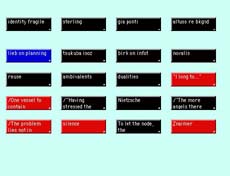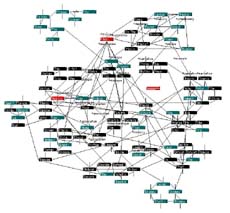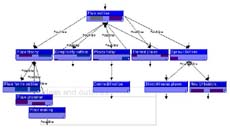index
The book and the hypertext
click on images for full-size:





The Tinderbox map of an early stage of this hypertext, which was merely a collection of scattered notes and quotations

The Tinderbox map for a portion of the "scenes" section of this hypertext

The Tinderbox map of the pyramid outline for a portion of this hypertext

Graph showing the distribution of wordcounts for different pages of this hypertext
This study began as scattered notes collected after I had written a book on architecture and postmodernism, and published a hypertext on non-linear presentations of philosophy and argument. Those notes attempted to approach from a new angle the question that I keep coming back to: how we might combine tradition and modernity. The project became more focused through invitations to address several Danish and Swedish groups. A sabbatical year provided the time to collect the by then voluminous notes, write, and travel with a laptop and camera. I went off to theme parks, European cities, and New Urbanist towns. The notes that led to this writing project were initially stored in a Storyspace hypertext file. As the project grew I adapted some of the notes into the book text, eliminated others, and collected still others for the hypertext. After a long period when the two versions grew in parallel, I put the hypertext aside and wrote a draft of the book. When I returned to the hypertext I found that the argument's voice and continuity was difficult to bring into the hypertext in any other way than in the form I call a "pyramid outline." Then I began adding in the narrative materials and complicating the overall organization. (The narrative material started out in hand-written travel notebooks, with some fictional additions and embellishments.) I worked the hypertext into a form where I could export it to HTML and show it for comments, and make revisions there. Then I revised the book manuscript several times. Then the hypertext had to be revised to keep up with the developing argument, which meant pulling it back from HTML into Eastgate System's Tinderbox, which has many facilities for linking and for keeping track of the structure. Then I revised the text and added the references for the images. Then the hypertext had to be re-exported to HTML and reworked for visual appeal and navigational ease. I was able to engage Jon Hicks to help with visual design and style sheets for the project.